|
|
Post by egalaxy on Feb 20, 2012 0:47:49 GMT -5
welcome to the first image of the day board post(below)!
all information is courtesy of APOD
|
|
|
|
Post by egalaxy on Feb 27, 2012 21:01:26 GMT -5
these are also known as APOD (astronomy photo of the day) info and picture courtesy of NASA, ESA and the HST  Twenty five years ago, the brightest supernova of modern times was sighted. Over time, astronomers have watched and waited for the expanding debris from this tremendous stellar explosion to crash into previously expelled material. A clear result of such a collision is demonstrated in the above time lapse video of images recorded by the Hubble Space Telescope between 1994 and 2009. The movie depicts the collision of an outward moving blast wave with the pre-existing, light-year wide ring. The collision occurred at speeds near 60 million kilometers per hour and shock-heats the ring material causing it to glow. Astronomers continue to study the collision as it illuminates the interesting past of SN 1987A, and provides clues to the origin of the mysterious rings. |
|
|
|
Post by egalaxy on Feb 28, 2012 17:27:25 GMT -5
Image Credit & Copyright: Robert Pölzl  Why does Comet Garradd have two tails? Visible on the left, Comet Garradd's dust tail is composed of ice and dust bits that trail the comet in its orbit around the Sun. Visible on the right, Comet Garradd's ion tail, is composed of ionized gas blown directly out from the Sun by the solar wind. Most comets show two tails, although it is unusual for them to appear to point in nearly opposite directions. Comet Garradd is currently showing opposing tails because of the Earth's opportunistic intermediate viewing angle. Subtle hues in the above image captured last week show the dust tail as slightly yellow as its large grains reflecting sunlight achromatically, while the ion tail shines slightly blue as the carbon monoxide ions reflect blue sunlight more efficiently. In the center, surrounding the comet's nucleus, is the green-tinted coma, so colored as it is a mix of dust and gasses that include green-emitting cyanogen. Although now drifting out from the Sun, Comet Garradd will make its closest approach to the Earth next week. |
|
|
|
Post by egalaxy on Feb 29, 2012 17:41:25 GMT -5
Image Credit & Copyright: Juan Carlos Casado (TWAN) 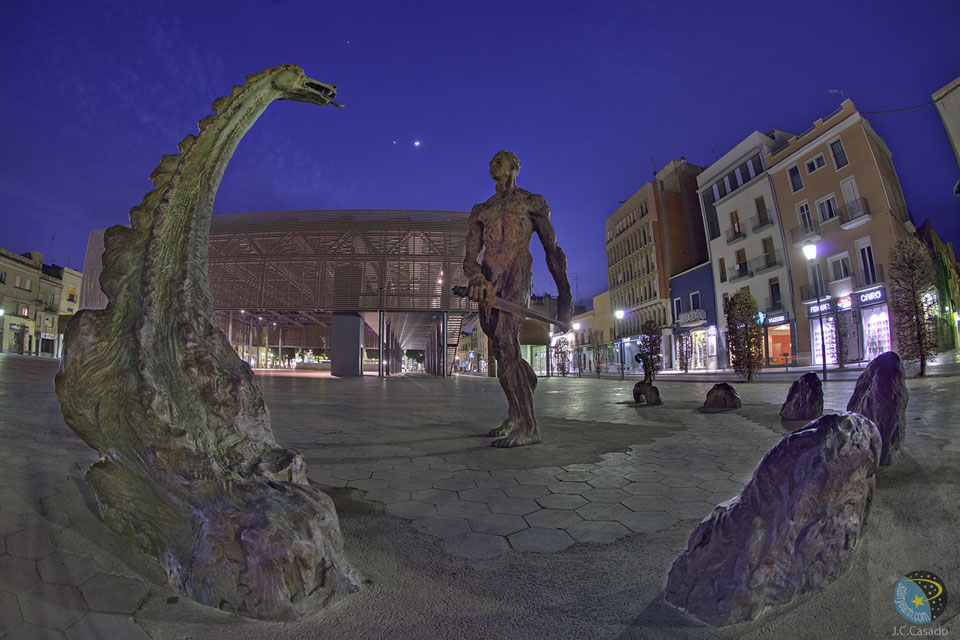 Venus and Jupiter will appear unusually close in the sky over the next month. The planetary conjunction will be easily visible to the unaided eye because Venus will appear brighter than any background star, and Jupiter will be nearly as bright. To see the near-alignment, simply look to the west after sunset. At their closest, on March 15, the two planets will appear only about three degrees apart. The planets will not be significantly closer in space - Venus will just be passing nearly in front of Jupiter as seen from the Earth. In the above image composite taken late last week from Catalonia, Spain, a bright crescent moon appears to the right of Venus, while Jupiter appears near the top of the image. The distant sun-illuminated spheres were photographed behind a sculpture depicting the legendary battle between a warrior and a dragon. A gallery of conjunction images is visible on the Asterisk -- APOD's discussion board. Please feel free to contribute. The next Jupiter-Venus conjunction will occur in May 2013. |
|
|
|
Post by egalaxy on Mar 1, 2012 17:35:12 GMT -5
Image Credit & Copyright: Sean Walker (SkyandTelescope.com, MASIL Astro-Imaging) 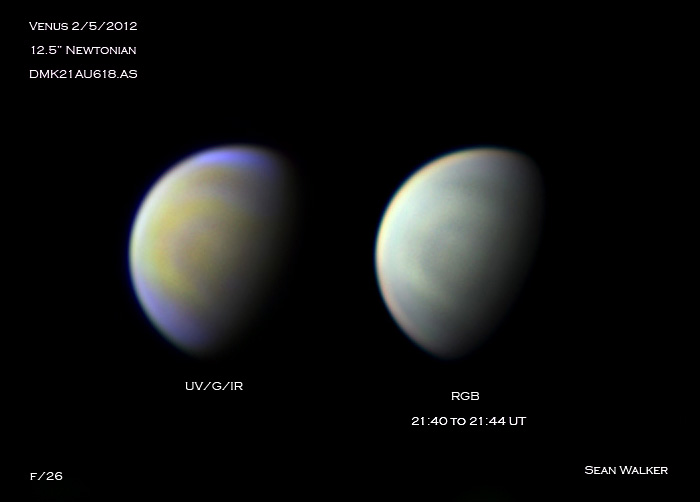 Brilliant Venus now shines in western skies at twilight. Seen as the prominent evening star, the planet is a tantalizing celestial beacon even for casual skygazers. Venus can offer less than satisfying telescopic views though. The planet is shrouded in reflective clouds that appear bright but featureless at the eyepiece. Still, careful imaging with a series of color filters, as used in these composite images, can reveal subtle cloud patterns. Captured early last month from a backyard observatory in Manchester, New Hampshire, USA, the images are based on video camera frames. The data was recorded through near-ultraviolet, green, and near-infrared filters (left), and red, green, and blue filters while Venus stood high above the western horizon just before sunset. This season's evening apparition of Venus is the best one for northern hemisphere observers in 7 years. It will ultimately end with a solar transit of the planet, the last one to occur in your lifetime, on June 5/6. |
|
|
|
Post by egalaxy on Mar 3, 2012 21:59:19 GMT -5
Image Credit & Copyright: Olivier Sedan (Sirene Observatory) 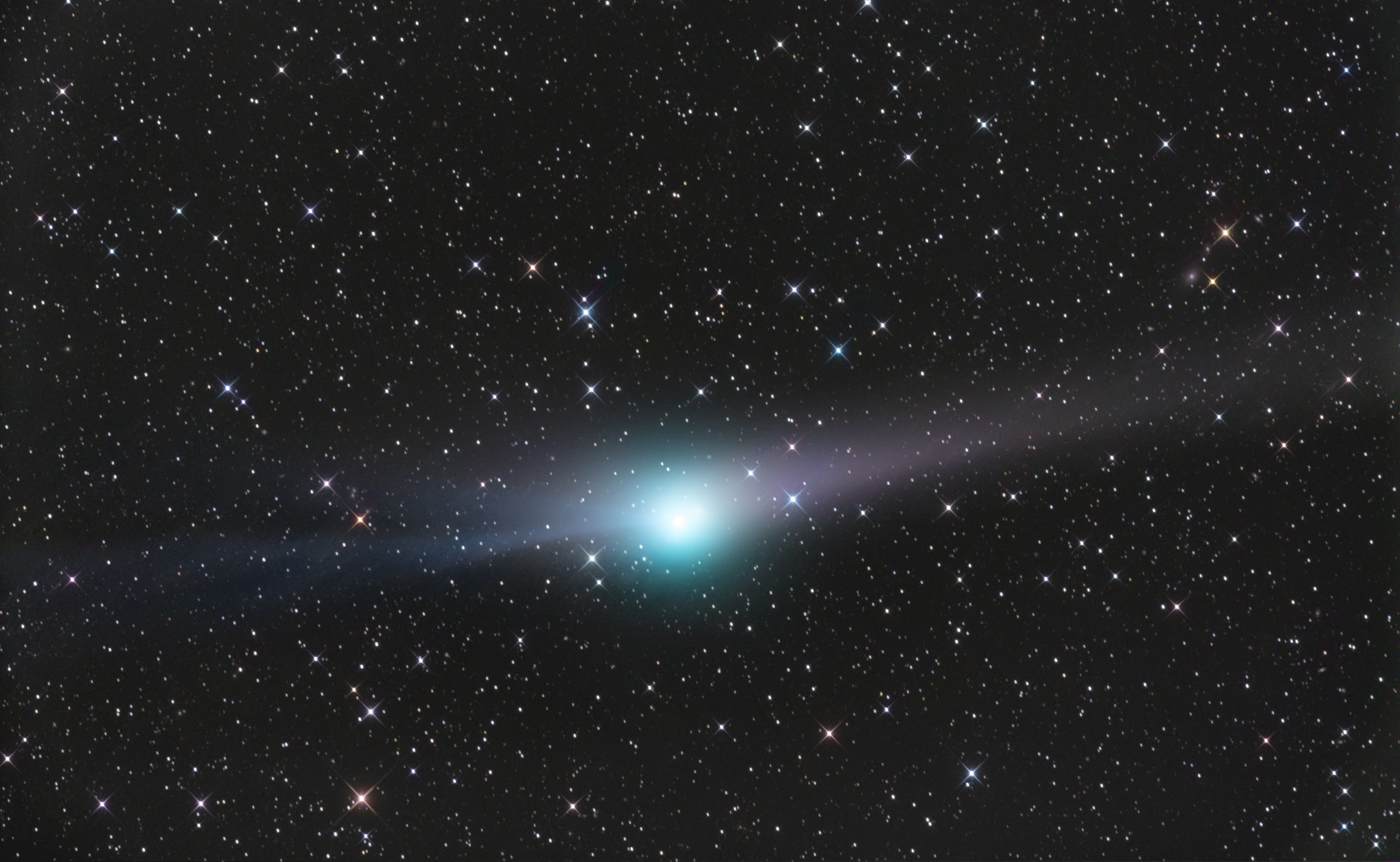 Remarkable comet Garradd (C2009/P1) has come to be known for two distinctive tails. From the perspective of earthbound comet watchers the tails are visible on opposite sides of its greenish coma. Seen here in a telescopic view, the recognizable dust tail fans out to the right, trailing the comet nucleus in its orbit. Streaming away from the sunward direction, a familiar bluish ion tail sweeps to the left. But the comet also seems to have, at least temporarily, sprouted a second ion tail recorded in this image from February 24. Other comet imagers have recently captured changing structures in Garradd's ion tail created as the plasma is buffeted by the magnetic fields in the solar wind. Now moving more quickly through northern skies, on March 5th comet Garradd will reach its closest approach to planet Earth, about 10.5 light-minutes distant. |
|
|
|
Post by egalaxy on Mar 4, 2012 9:52:12 GMT -5
Image Credit: Hubble Heritage Team (STScI/AURA), C. Conselice (U. Wisconsin/STScI) et al., NASA 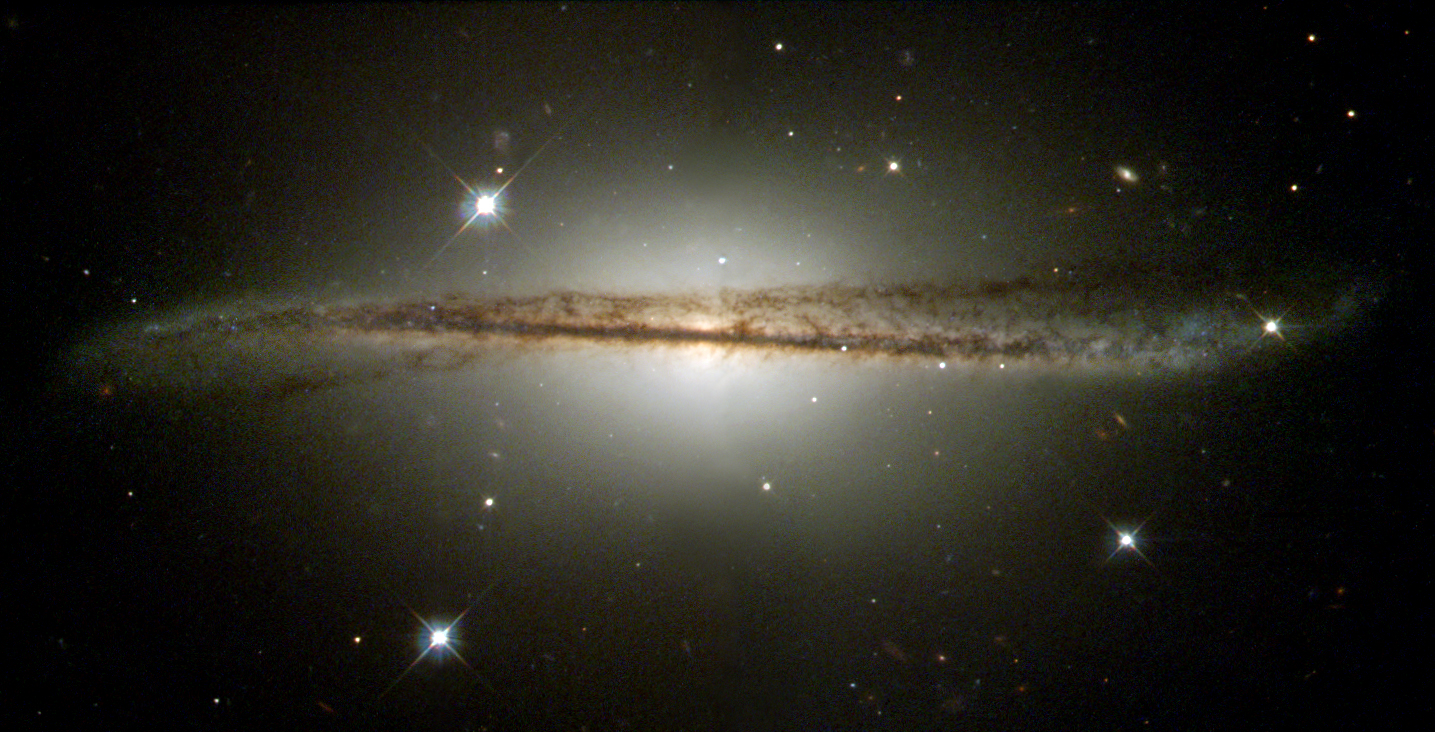 How did spiral galaxy ESO 510-13 get bent out of shape? The disks of many spirals are thin and flat, but not solid. Spiral disks are loose conglomerations of billions of stars and diffuse gas all gravitationally orbiting a galaxy center. A flat disk is thought to be created by sticky collisions of large gas clouds early in the galaxy's formation. Warped disks are not uncommon, though, and even our own Milky Way Galaxy is thought to have a small warp. The causes of spiral warps are still being investigated, but some warps are thought to result from interactions or even collisions between galaxies. ESO 510-13, pictured above digitally sharpened, is about 150 million light years away and about 100,000 light years across. |
|
|
|
Post by egalaxy on Mar 5, 2012 17:44:05 GMT -5
Video Credit: Gateway to Astronaut Photography, NASA ; Compilation: Bitmeizer (YouTube);
Music: Freedom Fighters (Two Steps from Hell)
Many wonders are visible when flying over the Earth at night. A compilation of such visual spectacles was captured recently from the International Space Station (ISS) and set to rousing music. Passing below are white clouds, orange city lights, lightning flashes in thunderstorms, and dark blue seas. On the horizon is the golden haze of Earth's thin atmosphere, frequently decorated by dancing auroras as the video progresses. The green parts of auroras typically remain below the space station, but the station flies right through the red and purple auroral peaks. Solar panels of the ISS are seen around the frame edges. The ominous wave of approaching brightness at the end of each sequence is just the dawn of the sunlit half of Earth, a dawn that occurs every 90 minutes.
|
|
|
|
Post by egalaxy on Mar 6, 2012 20:56:36 GMT -5
Image Credit & Copyright: Leonardo Julio & Carlos Milovic (Astronomia Pampeana) 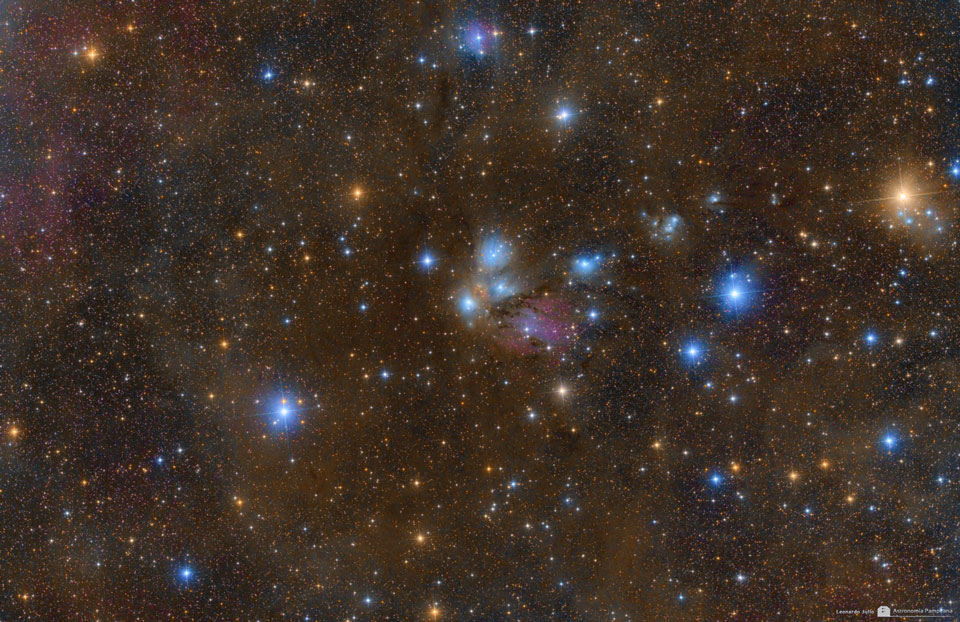 Is this a painting or a photograph? In this beautiful celestial still life composed with a cosmic brush, dusty nebula NGC 2170 shines near the image center. Reflecting the light of nearby hot stars, NGC 2170 is joined by other bluish reflection nebulae, a red emission region, many dark absorption nebulae, and a backdrop of colorful stars. Like the common household items still life painters often choose for their subjects, the clouds of gas, dust, and hot stars pictured above are also commonly found in this setting - a massive, star-forming molecular cloud in the constellation of the Unicorn (Monoceros). The giant molecular cloud, Mon R2, is impressively close, estimated to be only 2,400 light-years or so away. At that distance, this canvas would be over 60 light-years across. |
|
|
|
Post by egalaxy on Mar 9, 2012 14:19:56 GMT -5
this thread is currently closed due to things going on. we will re open after the jewish passover
|
|